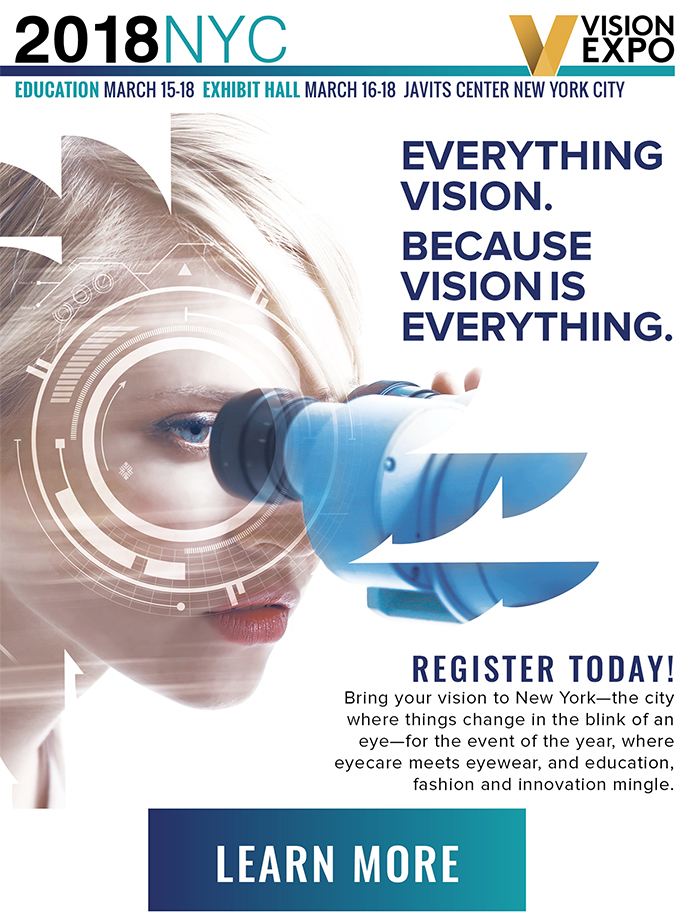In earlier years, the role of the optometrist was to wait until the patient developed a cataract that affected his or her ability to pass a driving test, then make a referral to a surgeon. That was the end of it.
Things have changed. Boomers in the optometrist’s patient base now have higher expectations and more active lifestyles, and they are more aware of their loss of quality of vision. They are much more apt to be interested in having this deficiency surgically corrected at an earlier stage, and they want to know their options.
There is a youth angle to boomers’ discontent as well. Boomers are very concerned about aging and, in general, actively take care of themselves to prevent or delay its telltale signs. The $14 billion phenomenon that is the cosmetic surgery industry, which employs nonsurgical and surgical procedures, speaks to boomers’ desire to stay young.
Unfortunately, the one sign of aging that patients cannot avoid is presbyopia. This age-related change in vision frustrates many patients, as it affects the near and intermediate tasks everyone performs daily. Surveys have found that the average boomer who has a cell phone checks it 46 times per day, while those who use the internet spend more hours surfing the net than watching TV.1,2
CHANGING LENSES
Many of these patients are also aware of the aging of their crystalline lens. New terminology has entered the world of cataract surgery.3 Normal lens changes have been termed dysfunctional lens syndrome (DLS).
Consider this scenario: Your patient in her late 50s comes in for her annual eye examination. She is correctable to 20/20, and slit-lamp examination shows normal age-related lens changes. You prescribe and dispense a new pair of glasses. A week later she is back in your office complaining that she just isn’t seeing properly out of these glasses. What is going on?
We all recognize that lens changes begin at the onset of presbyopia. This is now defined as DLS stage 1. In DLS stage 2, the lens continues to change and become more aberrated, and the patient loses some contrast acuity and becomes dissatisfied with the quality of vision. In DLS stage 3, a cataract develops.
TAKE CONTROL OF SURGERY
Cataract surgery is now considered a type of refractive surgery. This is where the optometrist now plays a key role. If we ultimately want to have happy patients, we must take control of the cataract surgery process.
Align yourself with a surgeon (or surgeons) looking to comanage surgical patients. Make sure you are happy with the lens options they offer. Ensure that you respect their surgical skills, that their outcomes are good, that they are accessible to you if needed, and that they appreciate your expertise.
DISCUSSIONS WITH PATIENTS
When you see patients with the beginnings of lens changes, mention these changes to the patient. Make patients aware that this is a progressive condition, that it is correctable, and that surgery can be done earlier rather than later if they so choose.
Ensure that patients are aware of their surgical options. Discuss astigmatism correction with them if it is applicable. (Remember: corneal astigmatism will still be present after surgery.) Discuss the latest IOL technologies with your patients. Inform them that today’s lenses are different from older versions, with better quality of vision, better ranges of vision, and reduced night vision issues. Review options such as extended depth of focus and multifocal lenses. Help patients determine what would make them happy.
Also make sure that, if patients elect to receive a monofocal IOL implant, they understand the ramifications for their near vision. Patients, especially low-to-moderate myopes, don’t necessarily understand the concept that correcting their distance vision with a monofocal IOL will make them completely dependent on readers for all near tasks. In other words, they will get rid of their cloudy lens, but preserve their presbyopia.
Ensure that patients have a healthy ocular surface before you send them to the surgeon. Dry eye can significantly alter preoperative biometry measurements, and this can be responsible for a less-than-ideal postoperative refractive outcome as well as for visual fluctuations and discomfort.
Finally, make sure you are familiar with the postoperative protocol the surgeon uses, and let the surgeon know when you are comfortable taking over the patient’s care.
KEEP PATIENTS HAPPY
Optometry is vision care, and vision care includes perioperative care. These are your patients, and hopefully they will continue to be so for years to come. By taking charge of the surgical encounter as described above, you can help to ensure that they are happy with the results and that they remain loyal to your practice.
- Reaching Today’s Boomers and Seniors Online. Google. https://www.thinkwithgoogle.com/consumer-insights/reaching-todays-boomers-and-seniors-online/. Updated May 2013. Accessed January 2, 2018.
- Boomers Underindex for Smartphone Ownership by a Wide Margin. eMarketer. https://www.emarketer.com/Article/Boomers-Underindex-Smartphone-Ownership-by-Wide-Margin/1013177. Updated November 2, 2015. Accessed January 2, 2018.
- Dysfunctional Lens Syndrome, a New Way to Educate Patients. American Academy of Ophthalmology. https://www.aao.org/eyenet/academy-live/detail/dysfunctional-lens-syndrome-educate-patients. Updated October 14, 2016. Accessed January 2, 2018.






